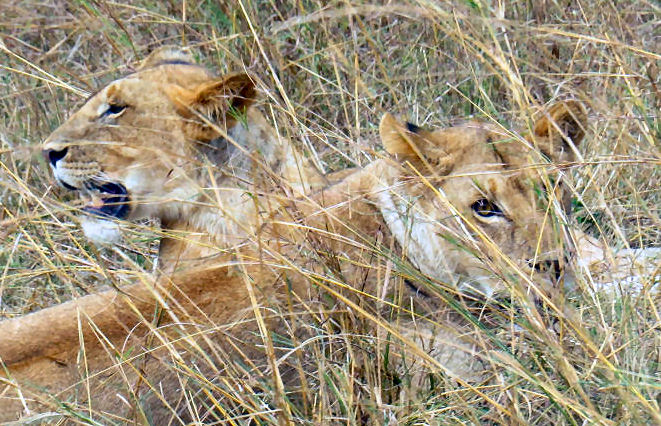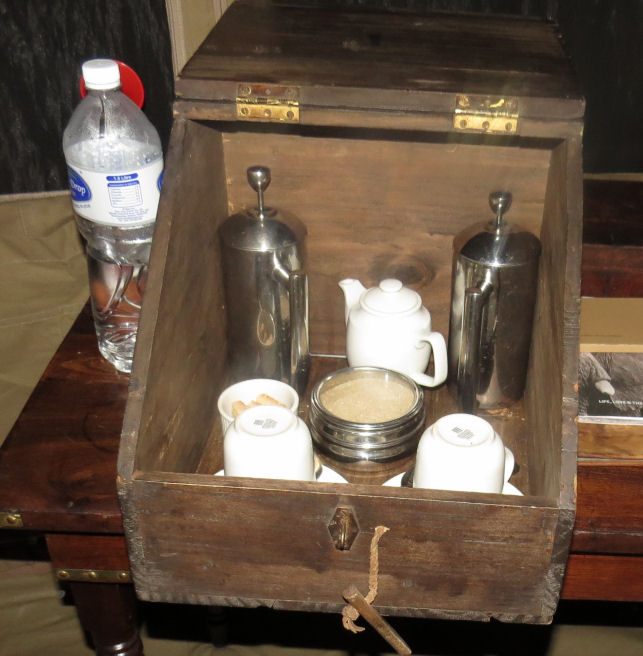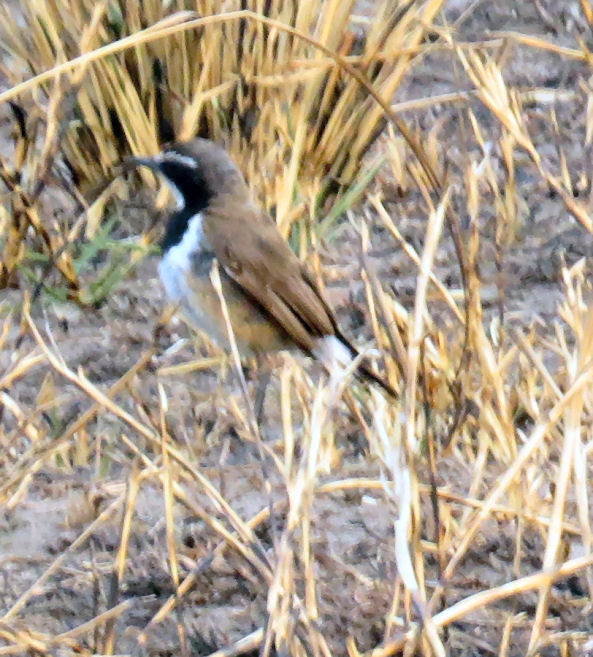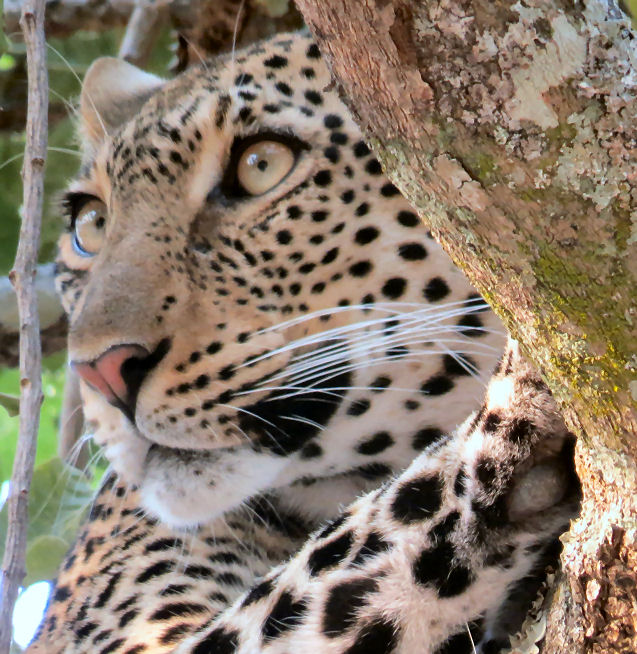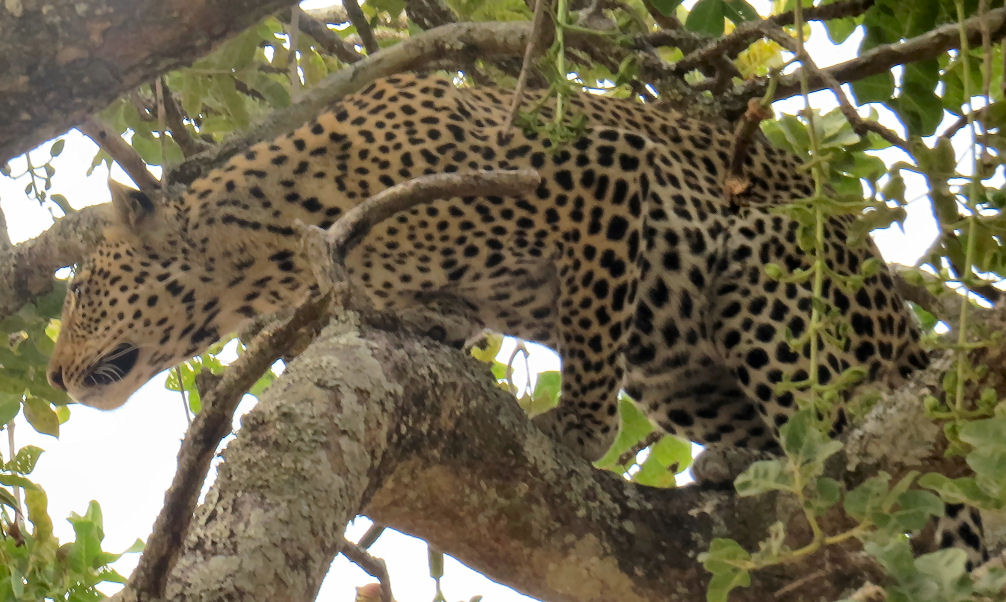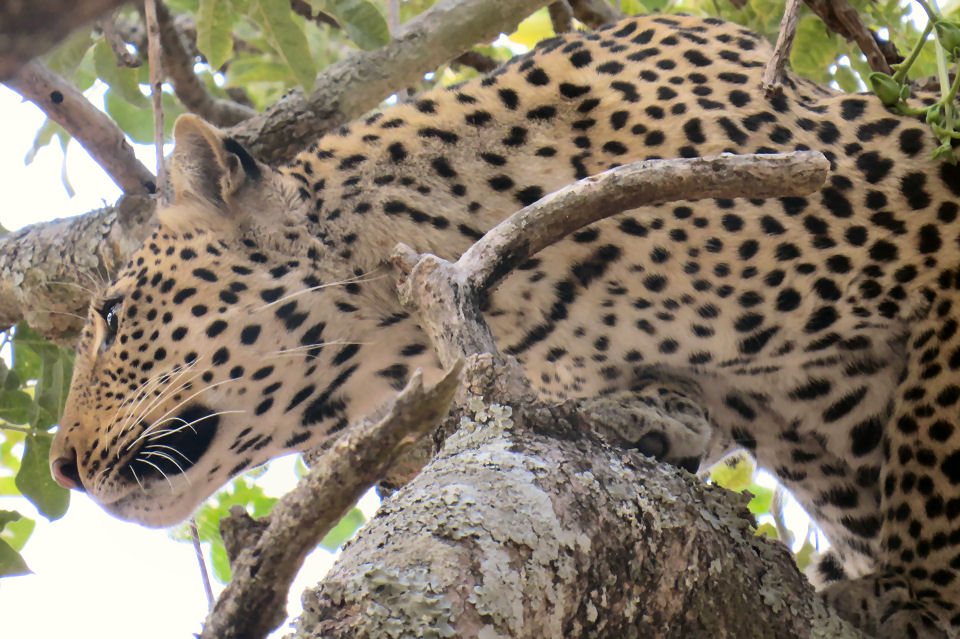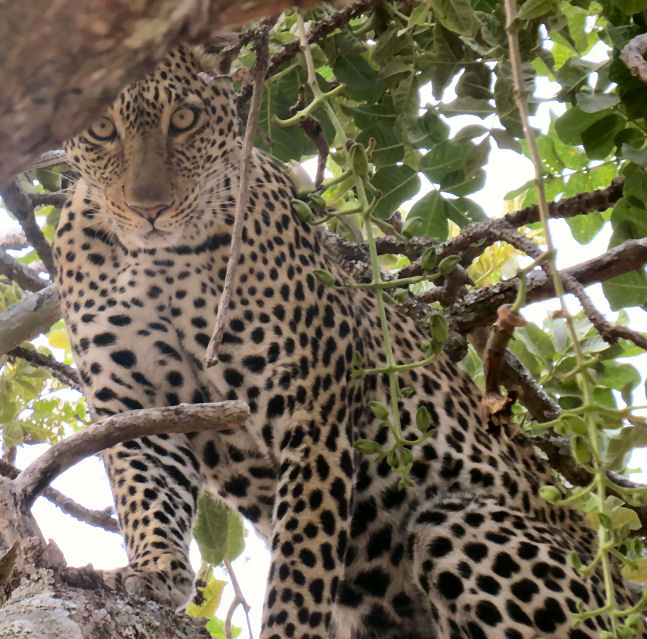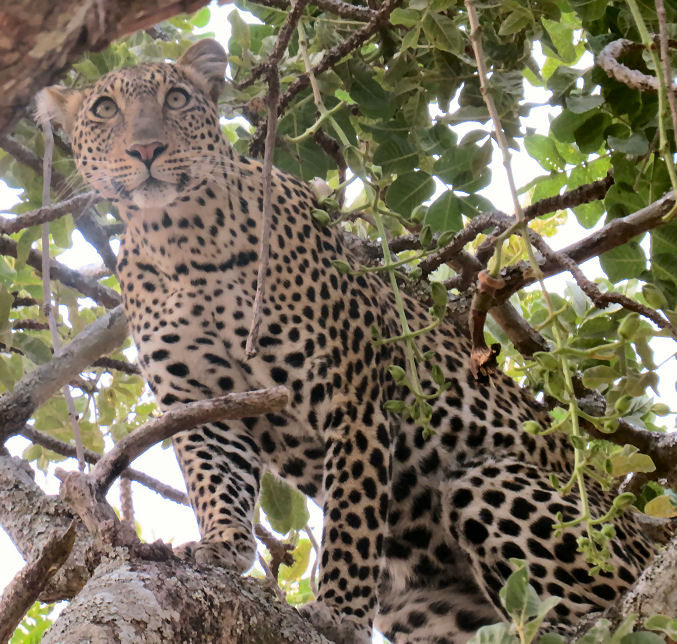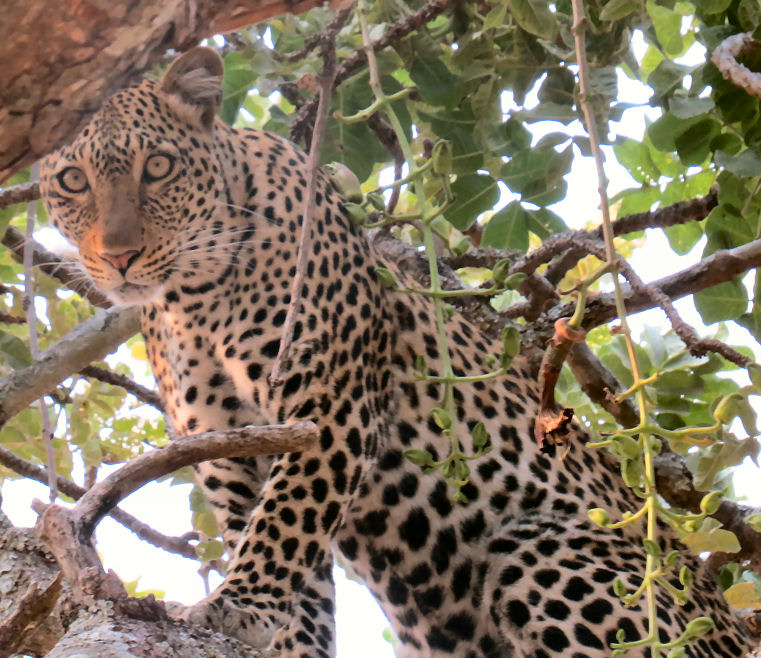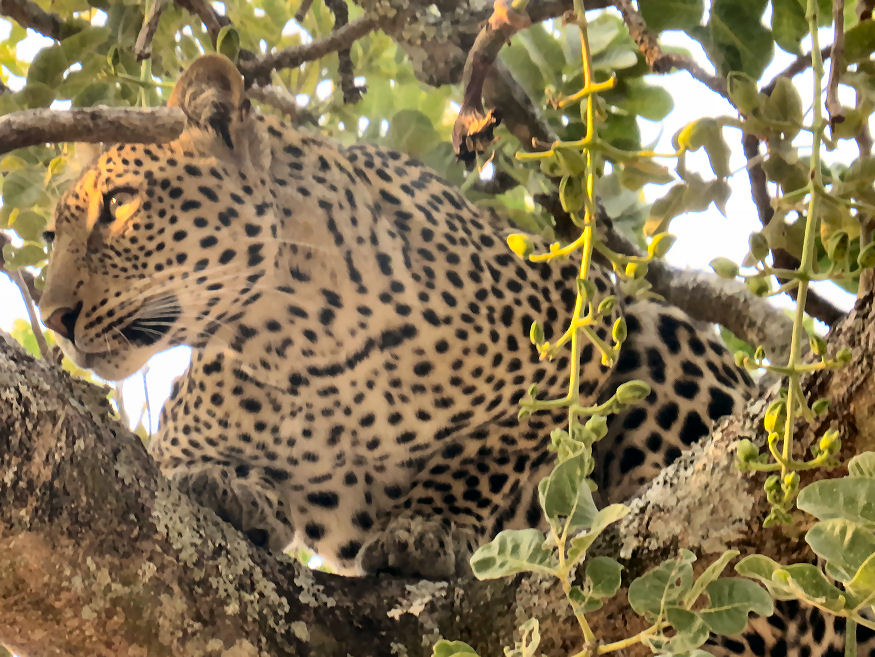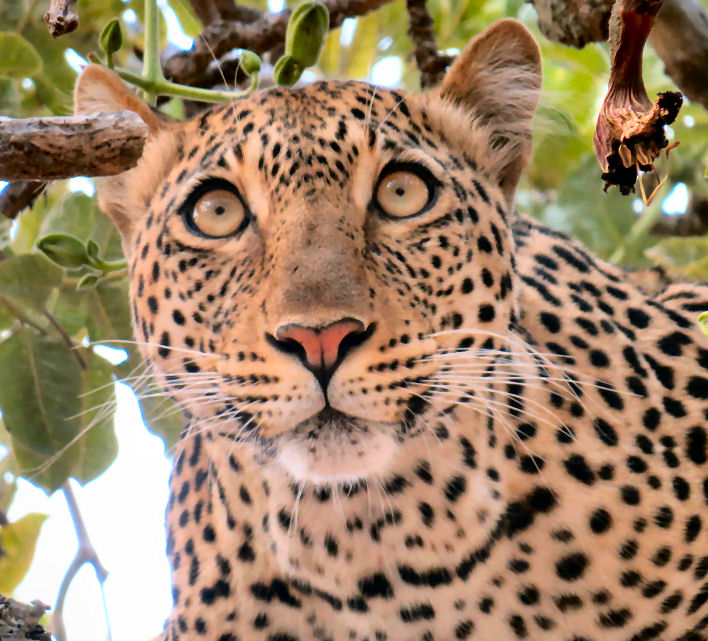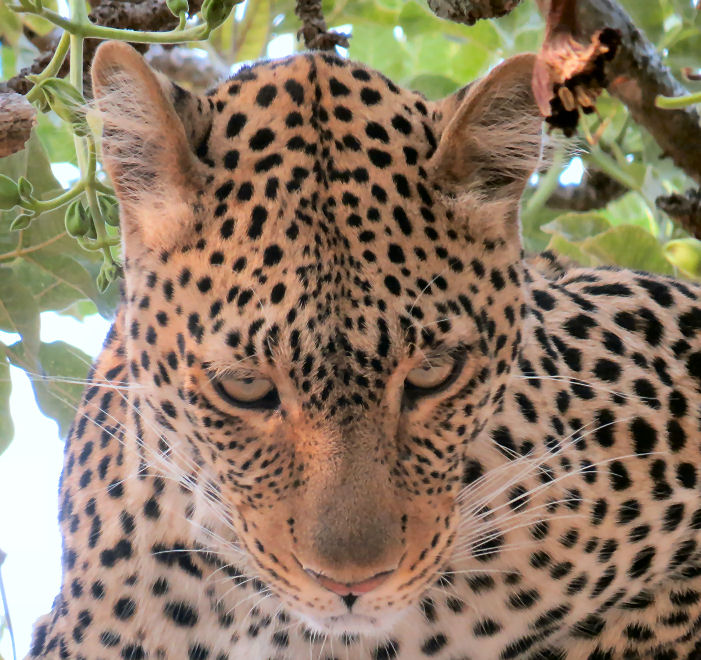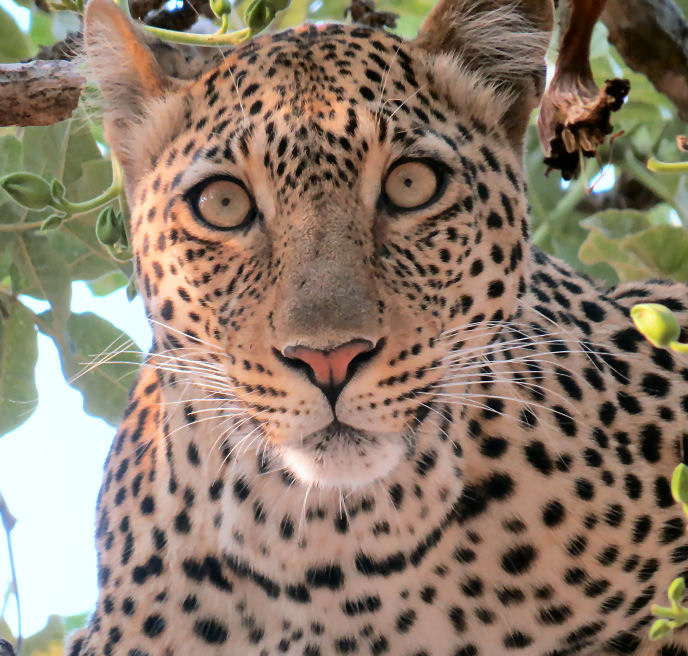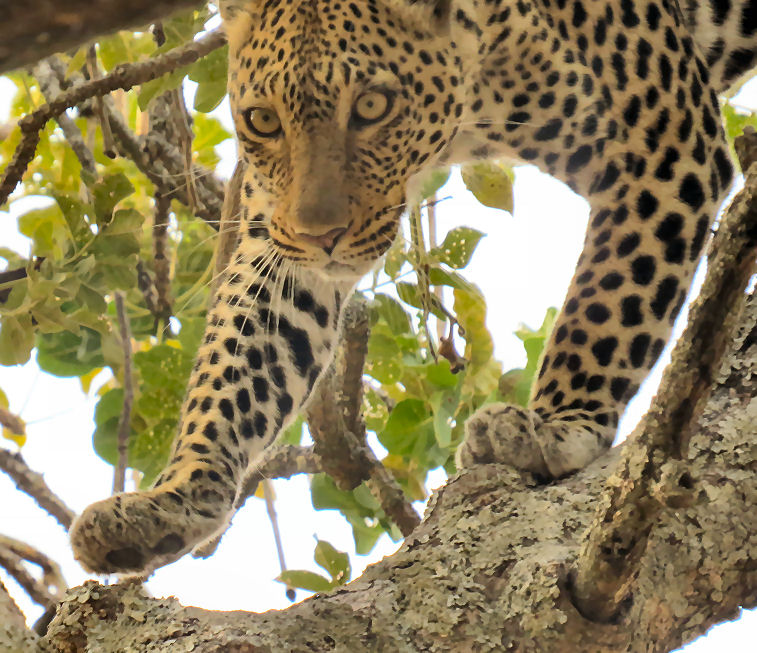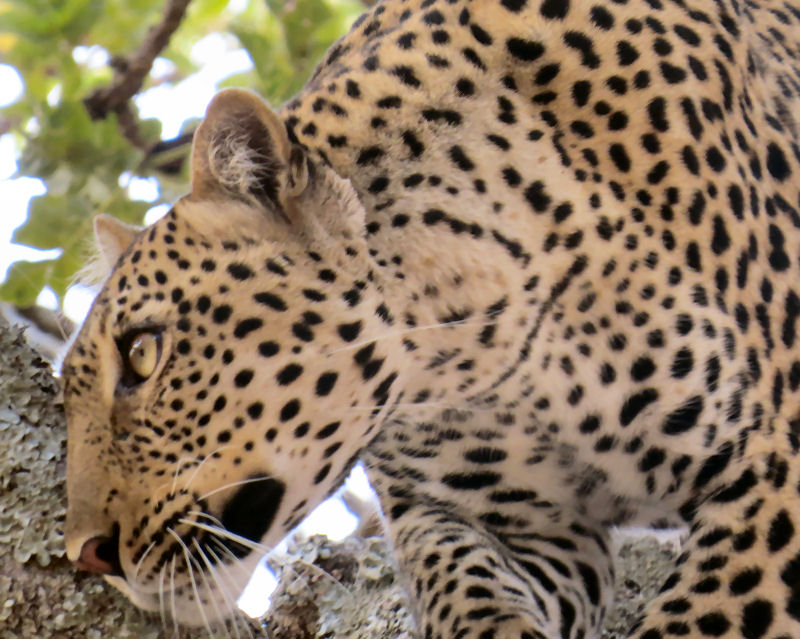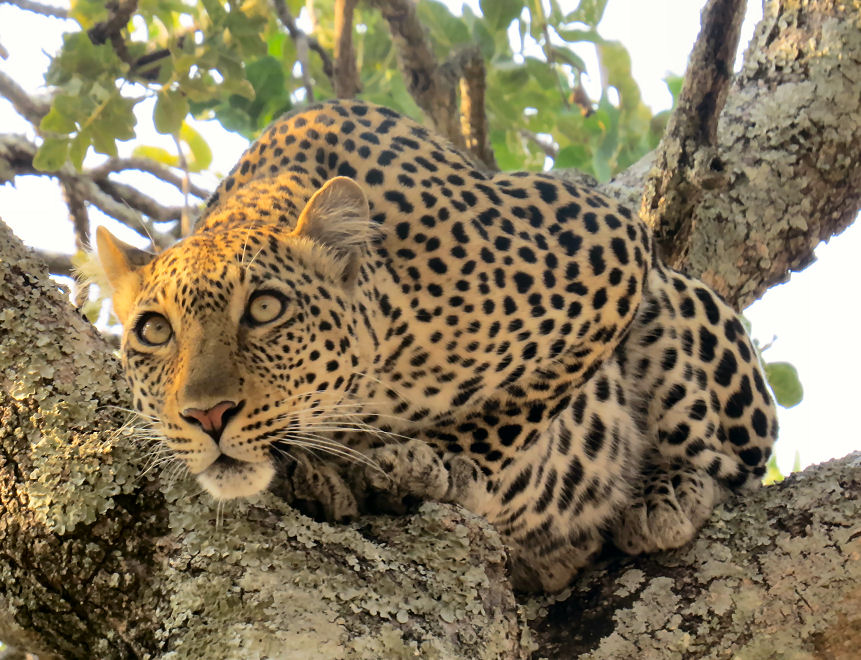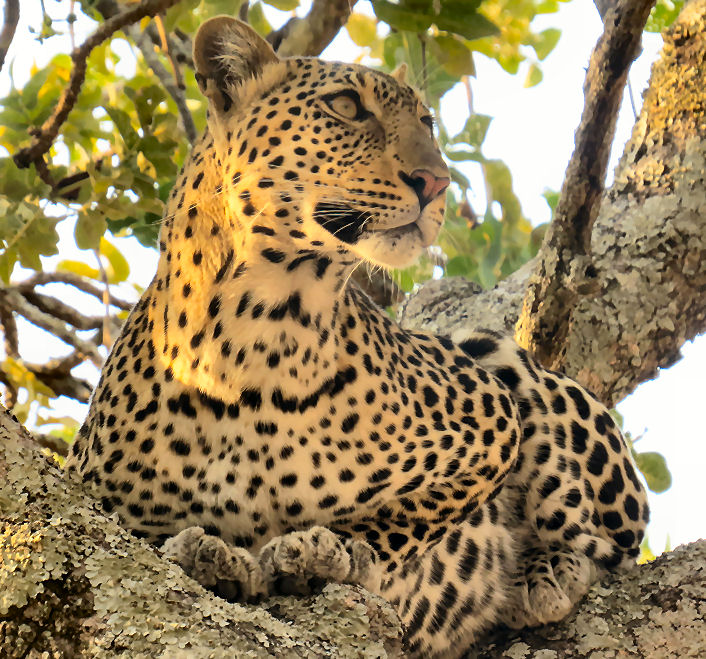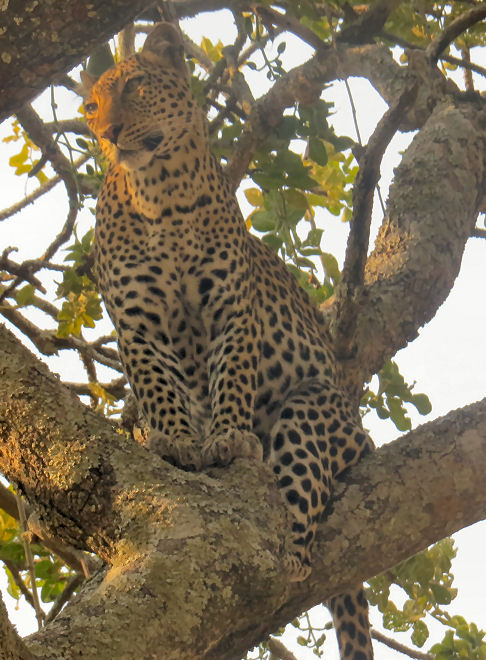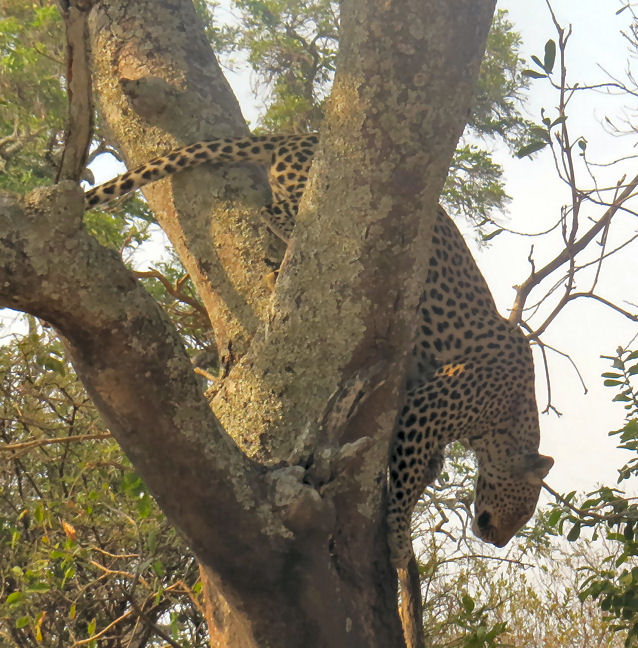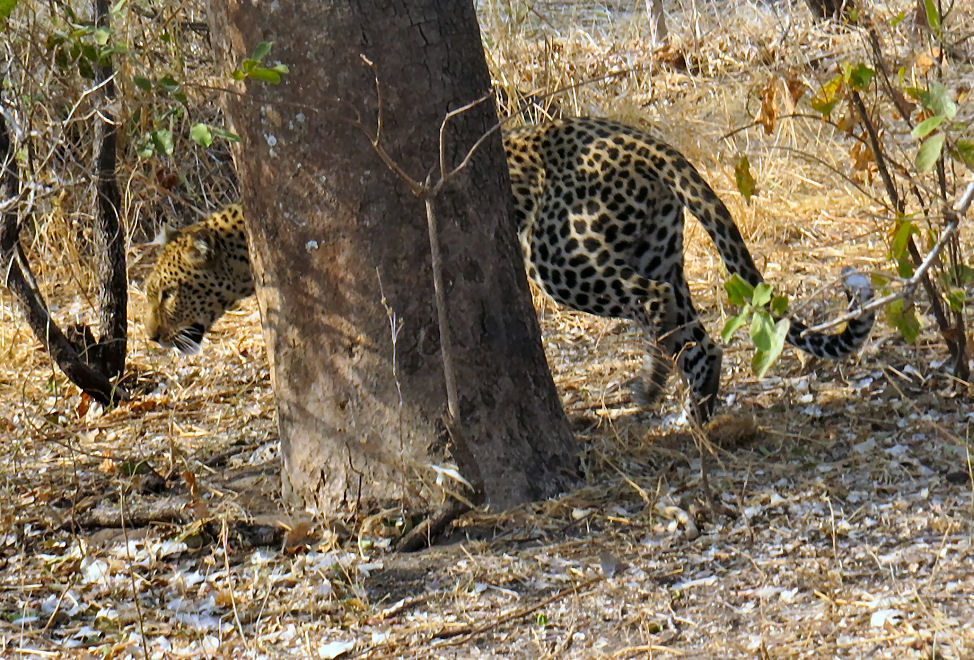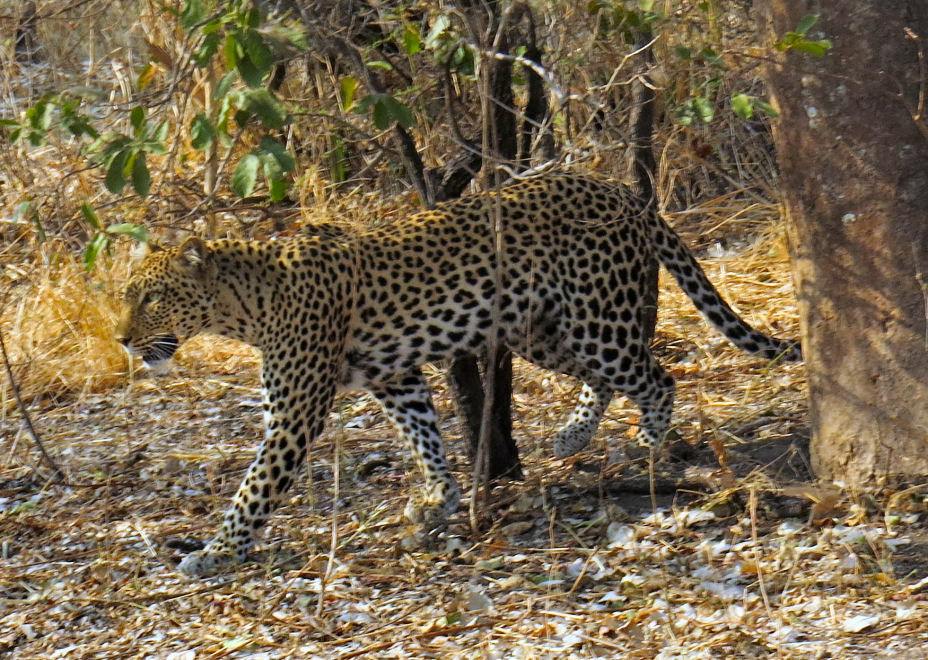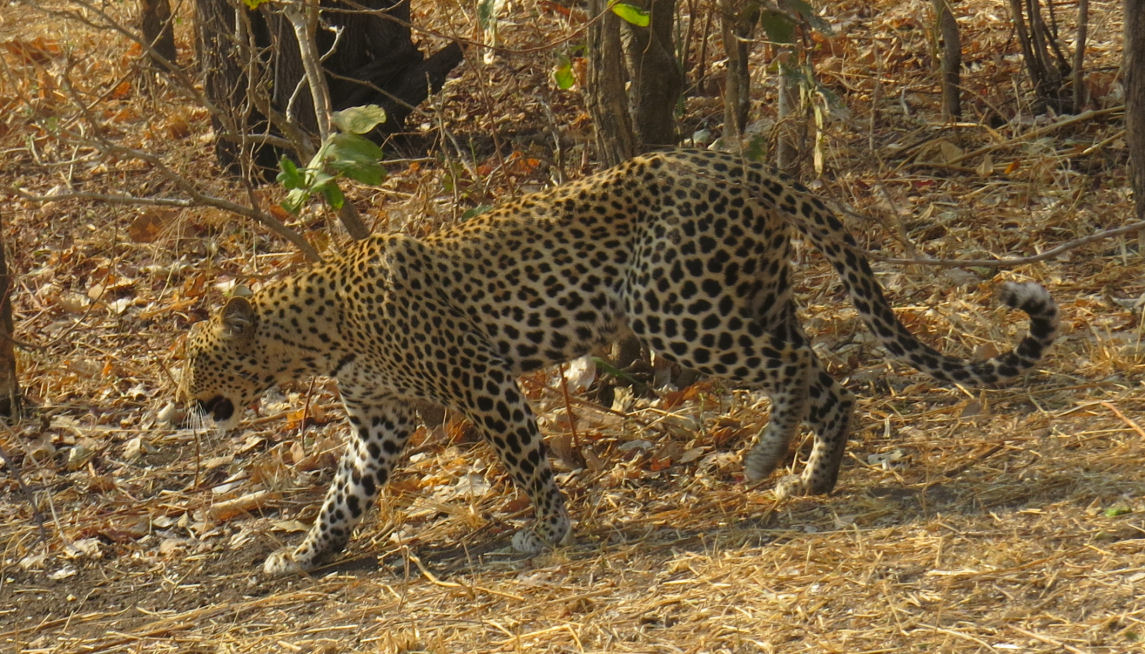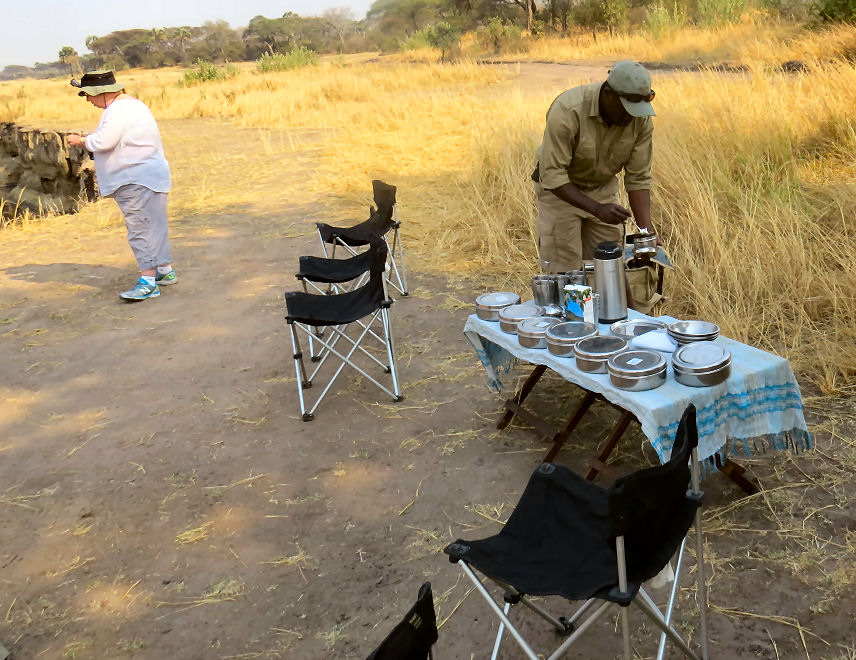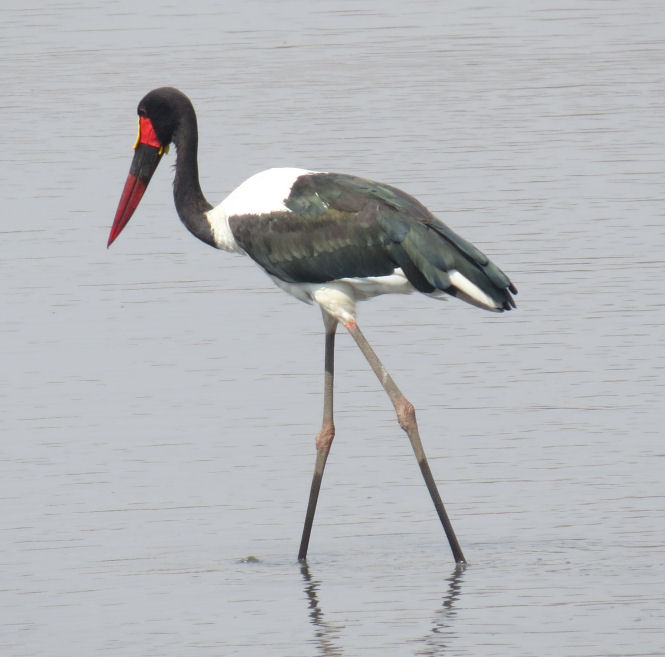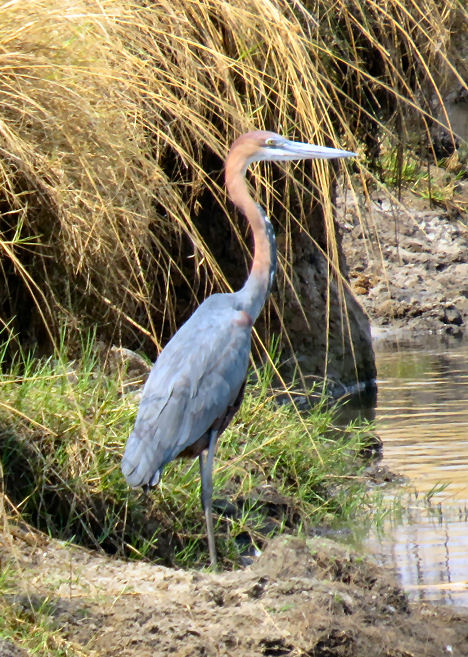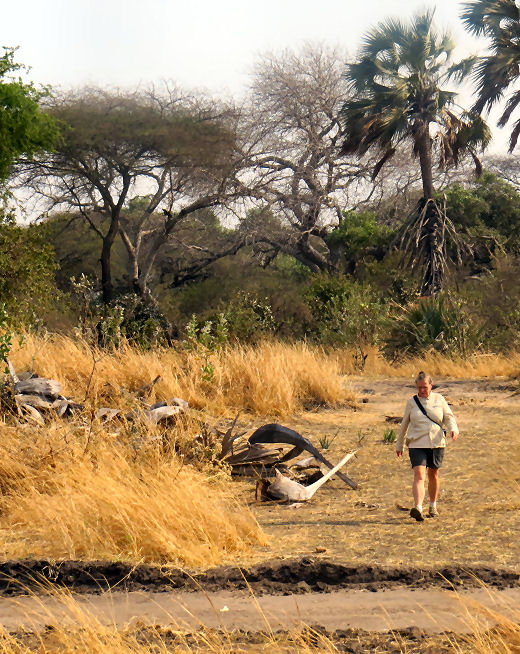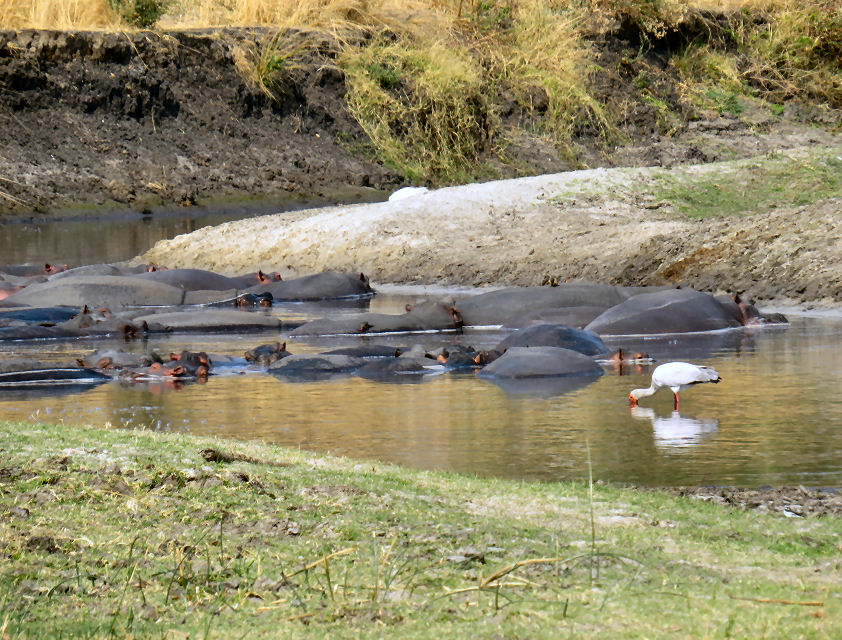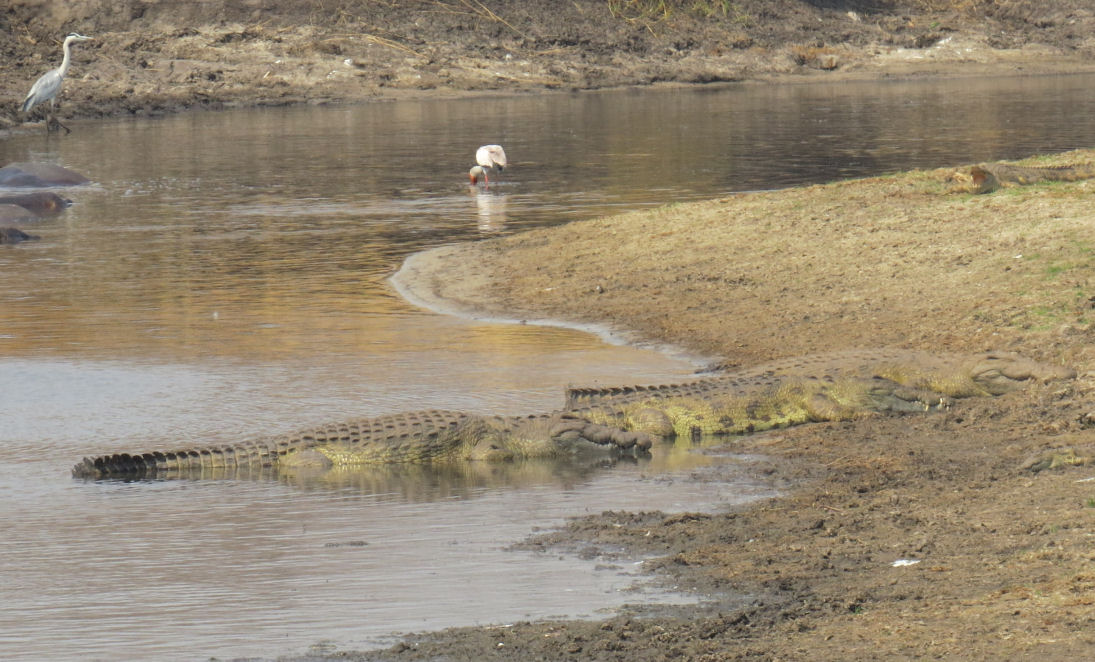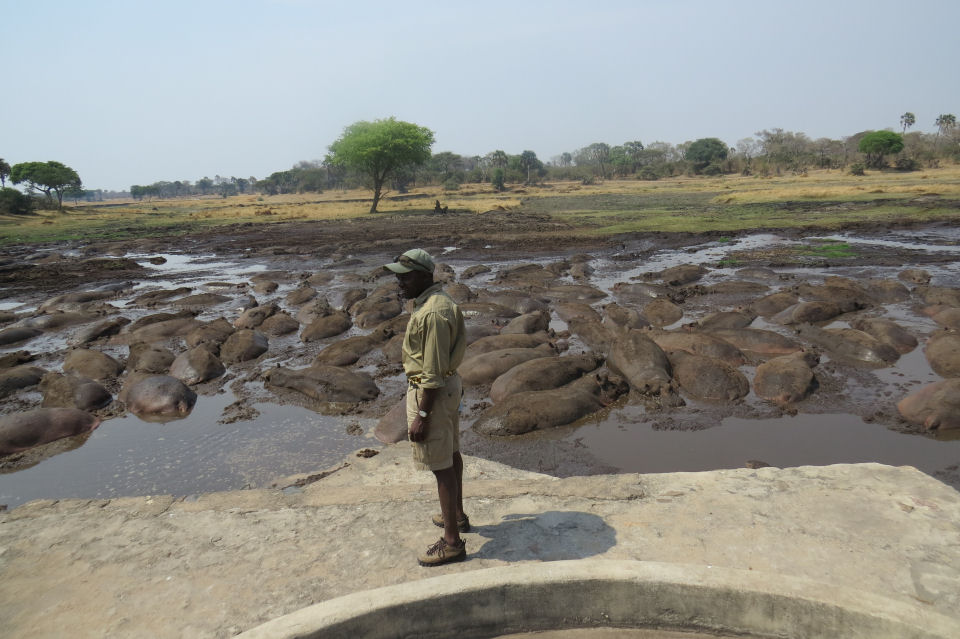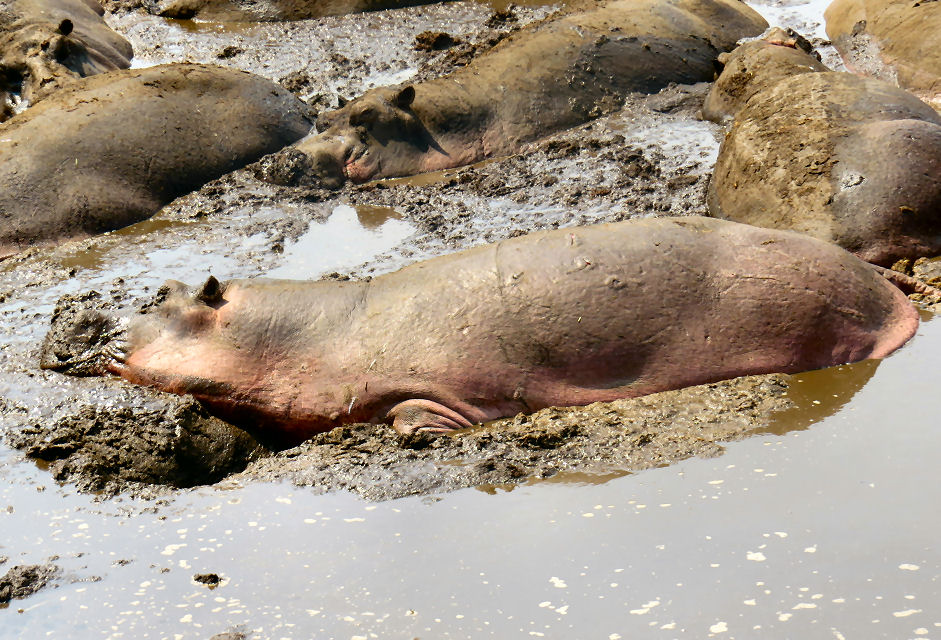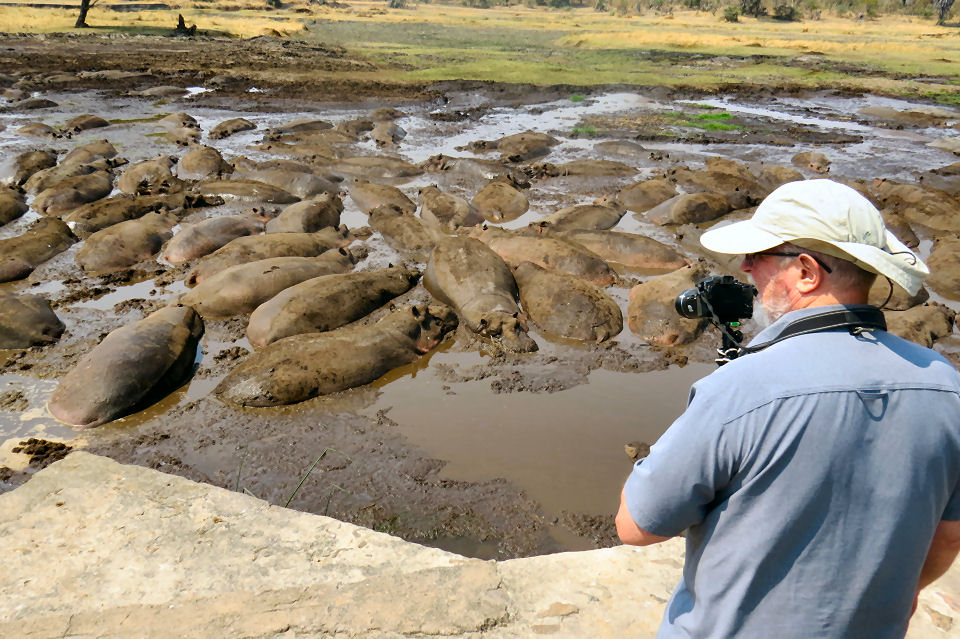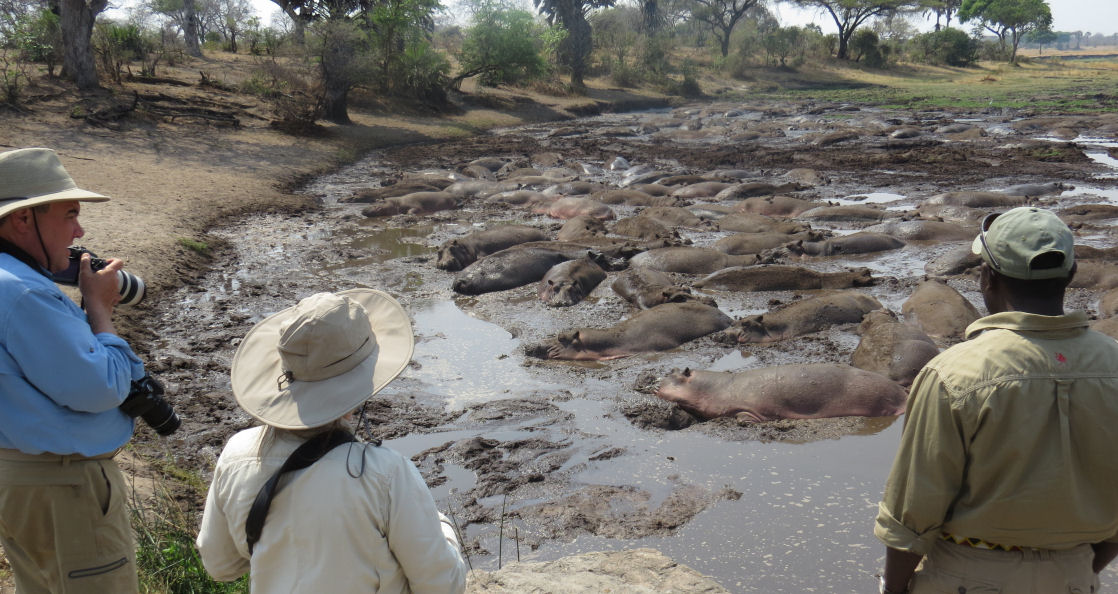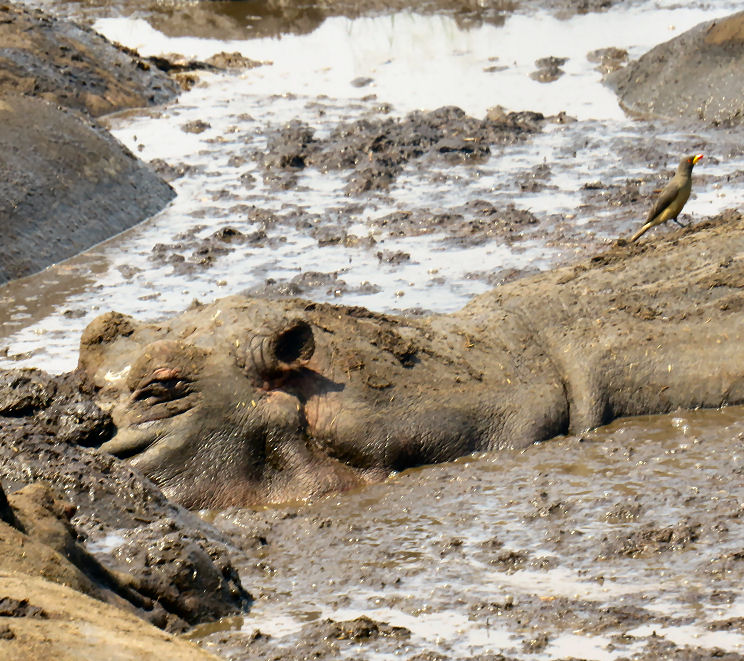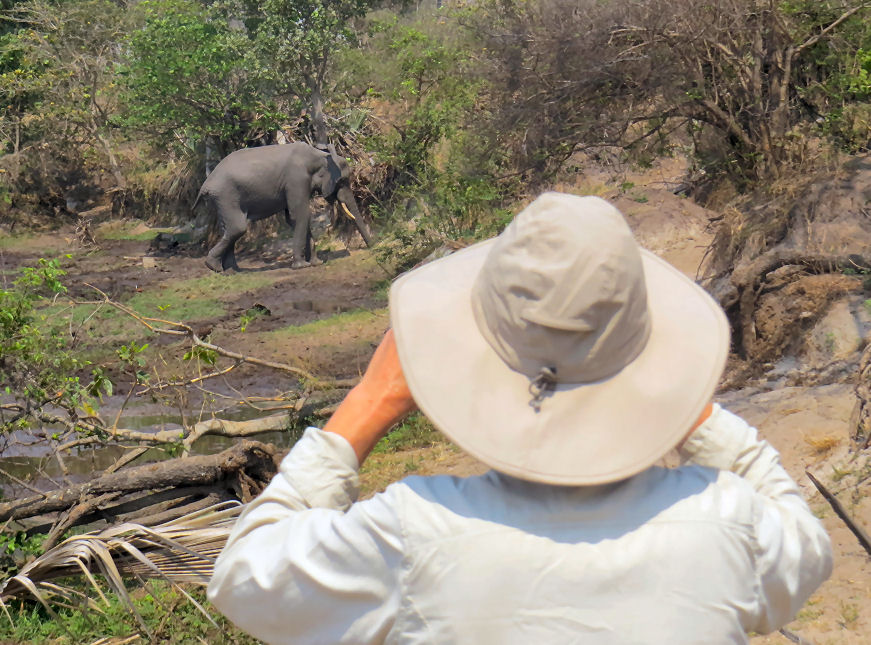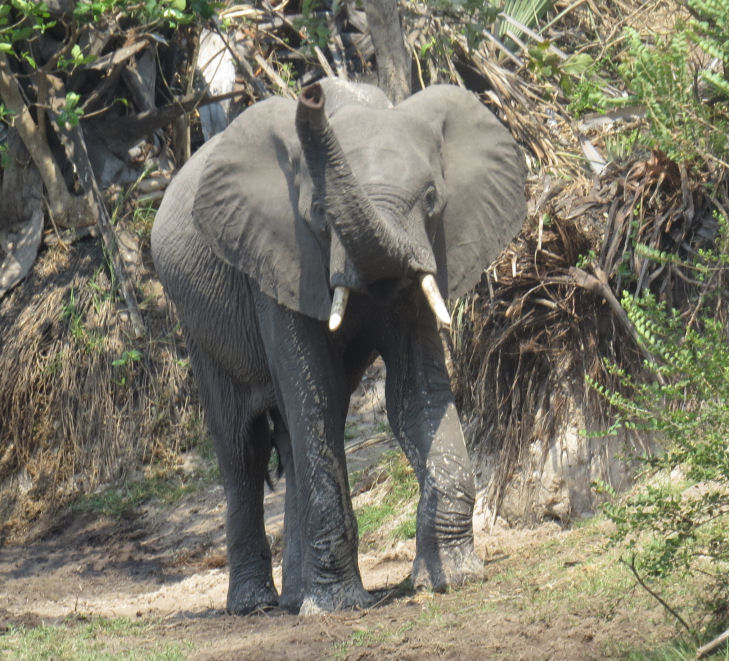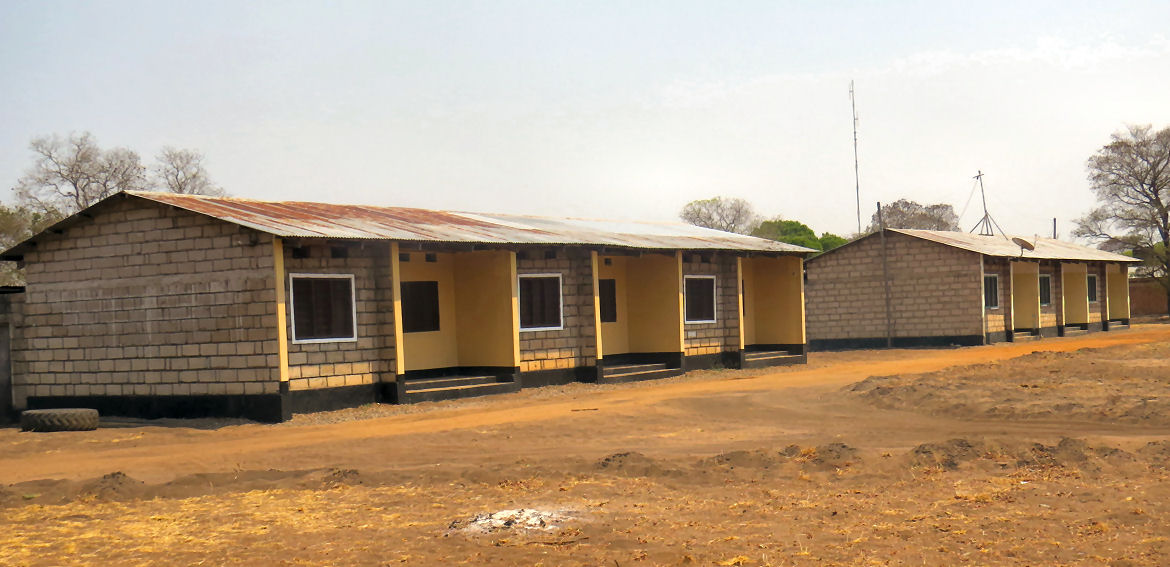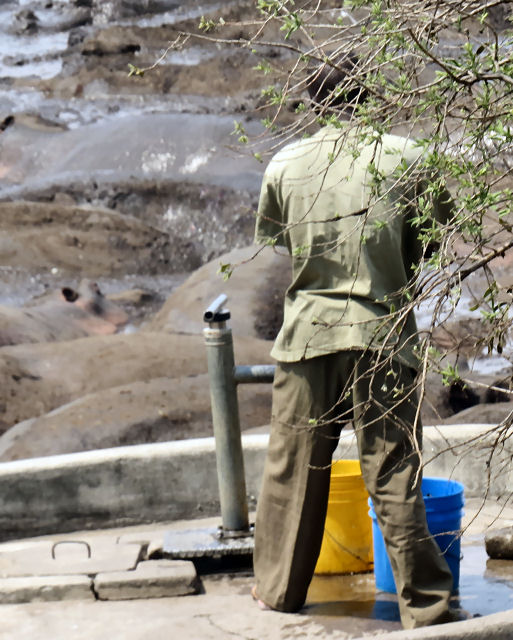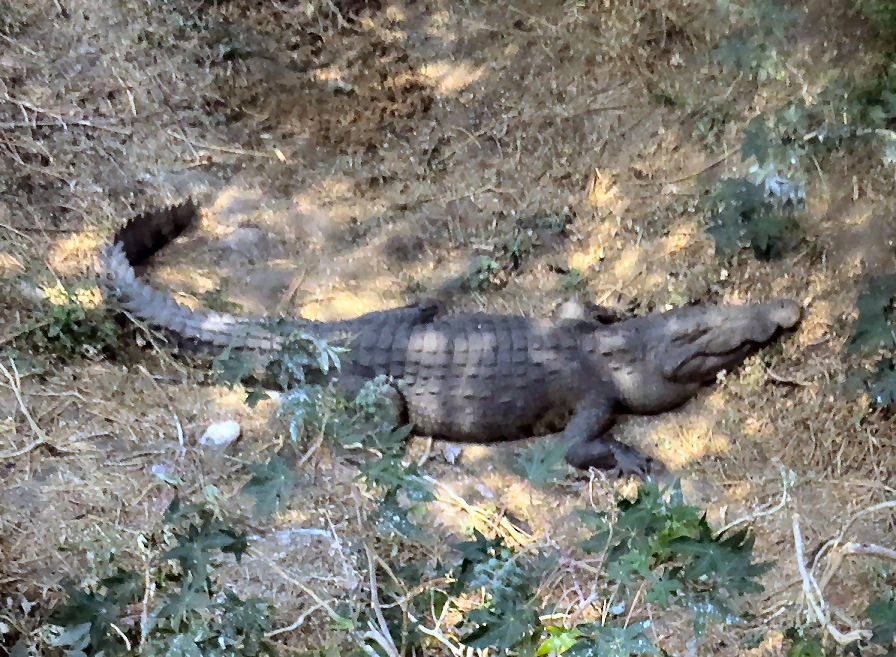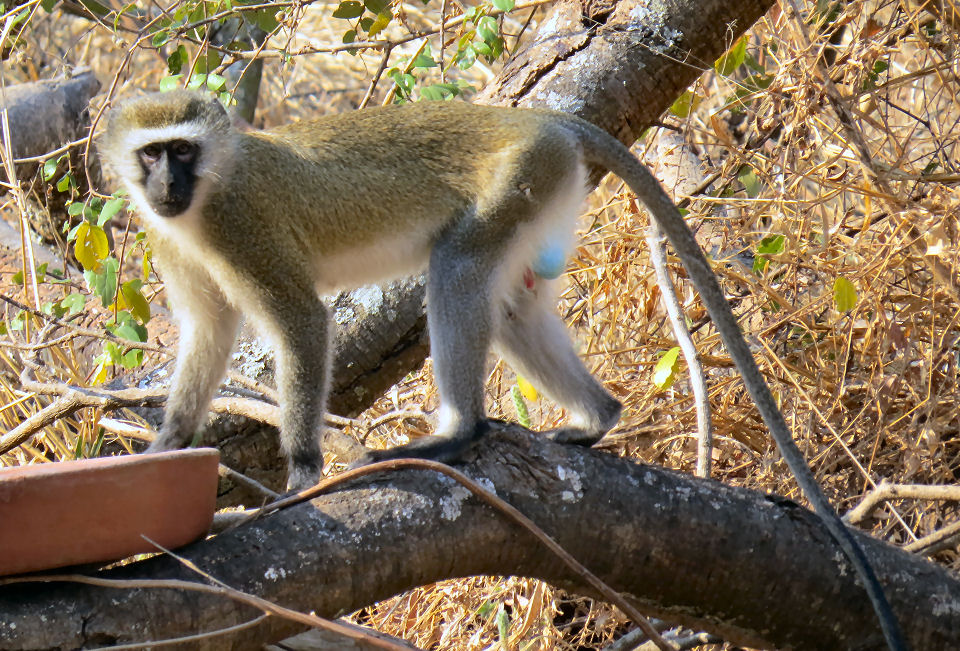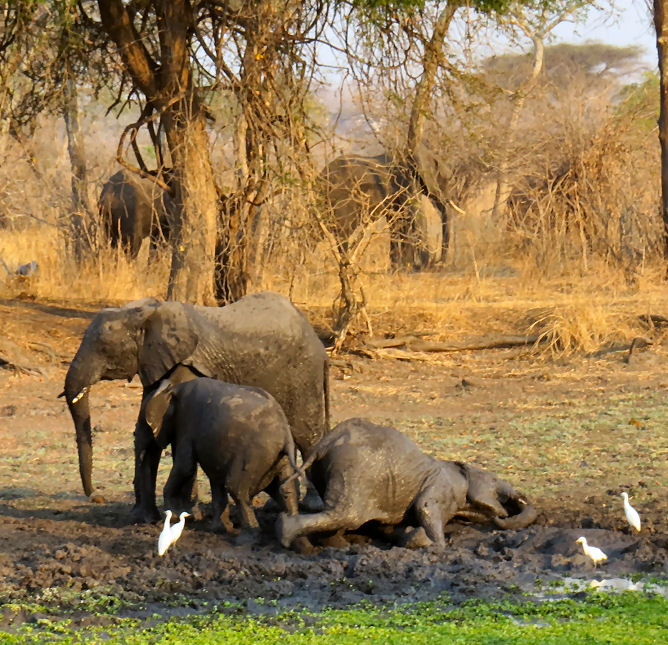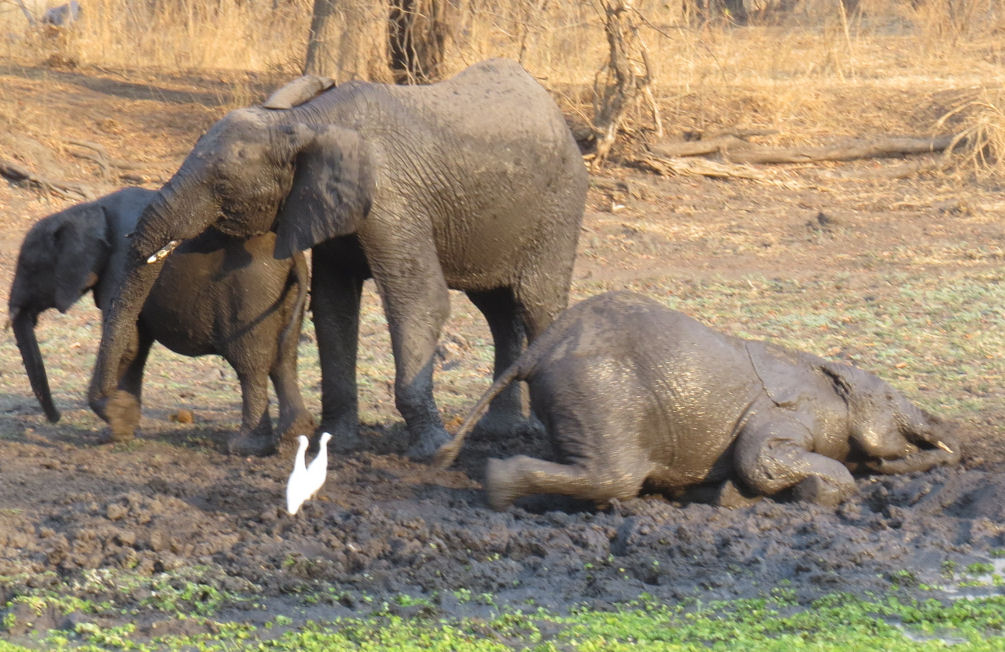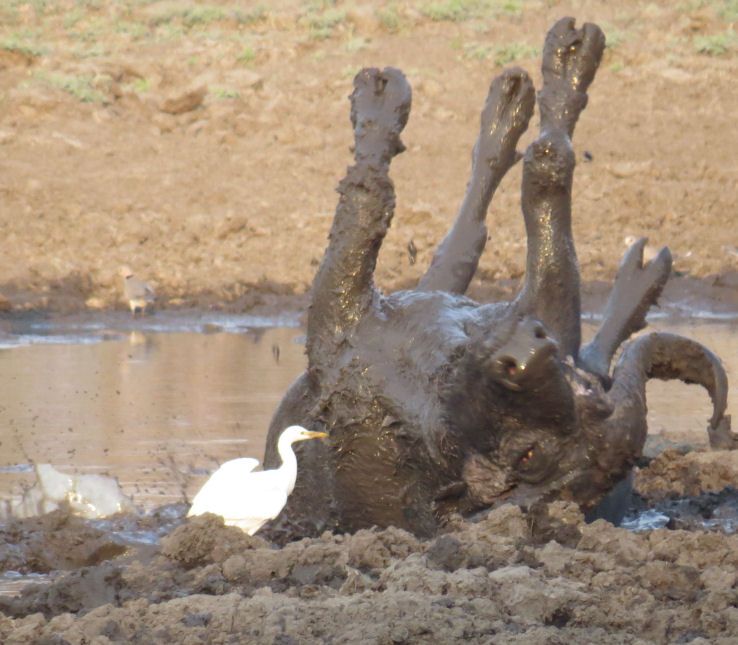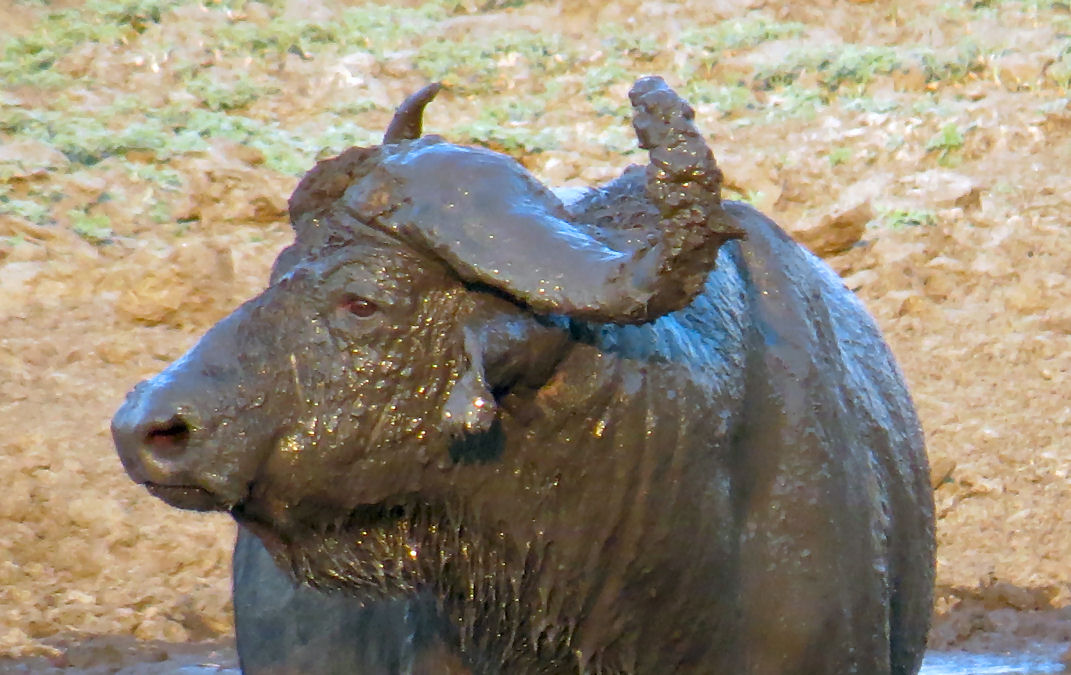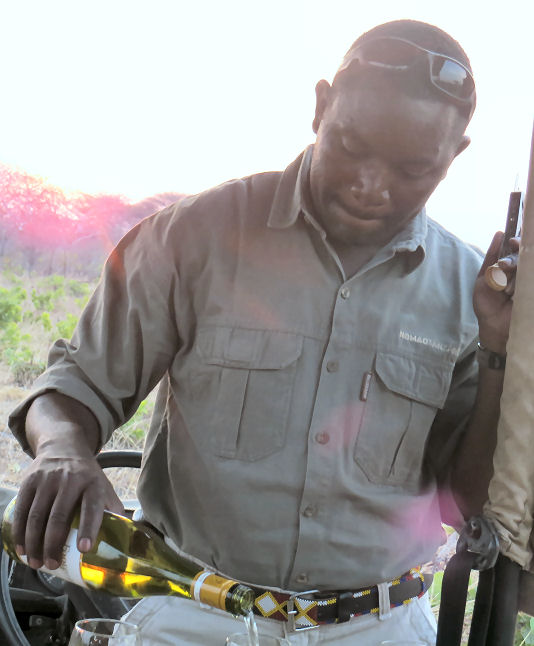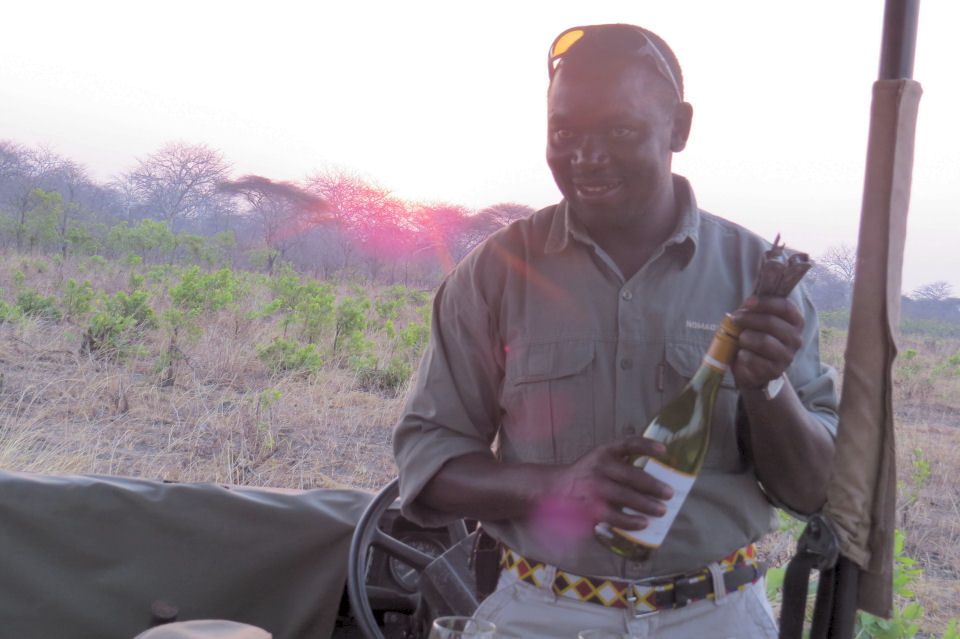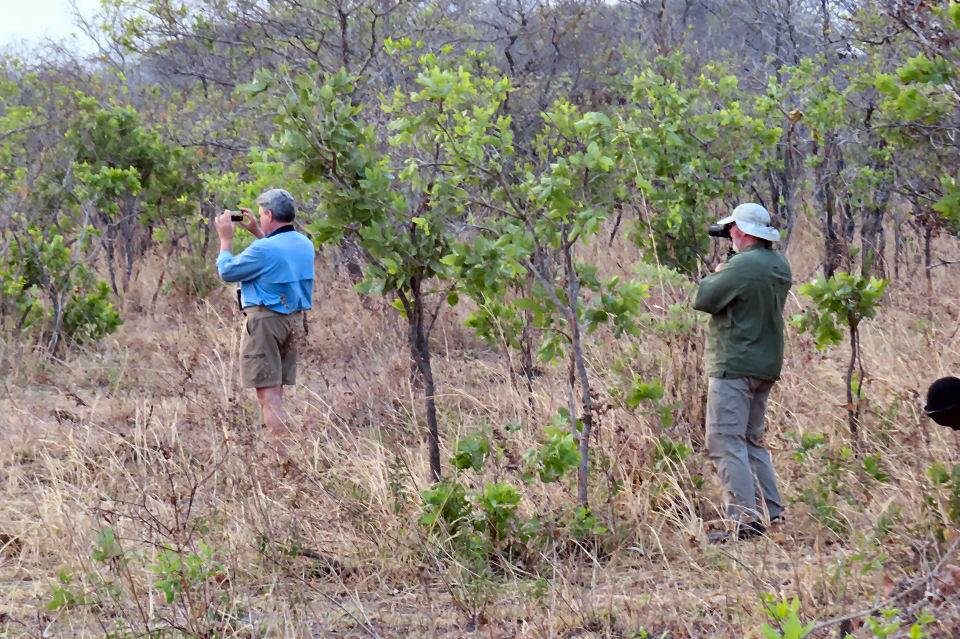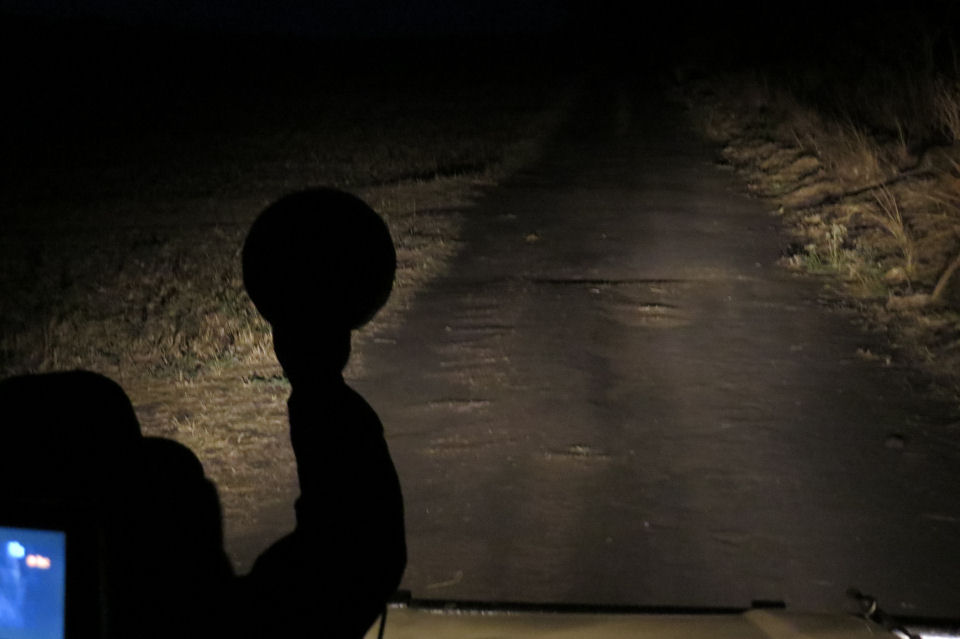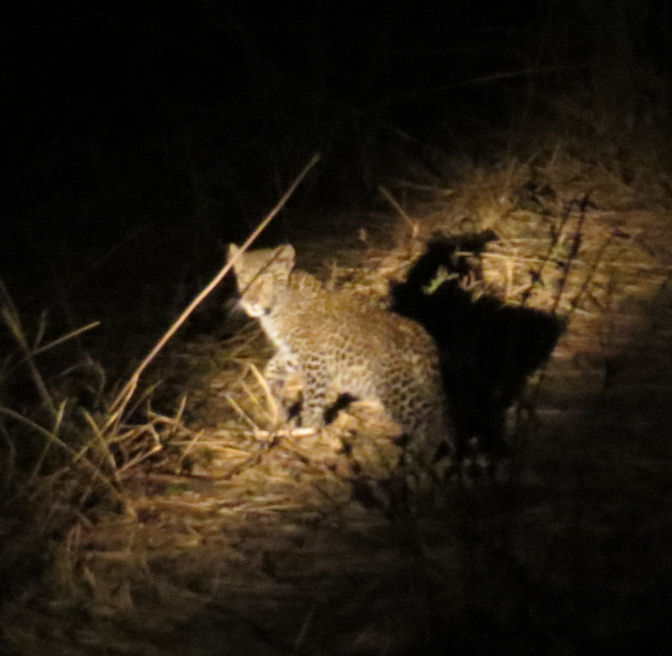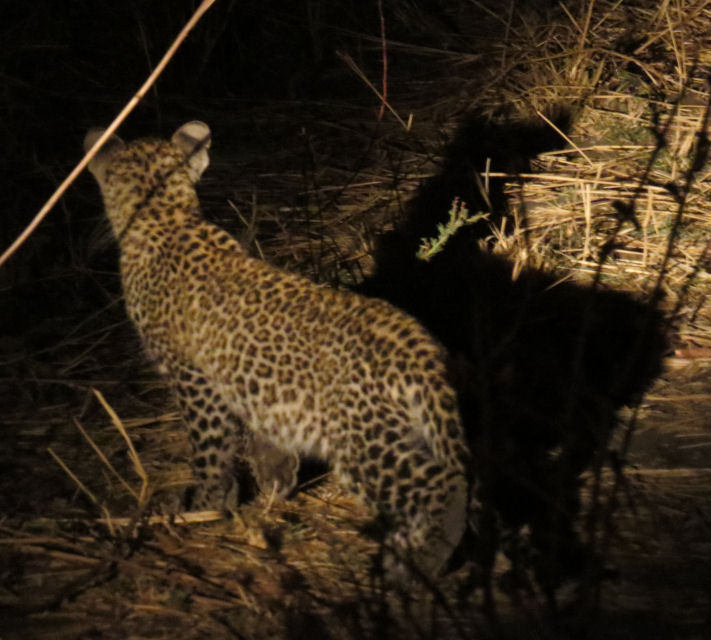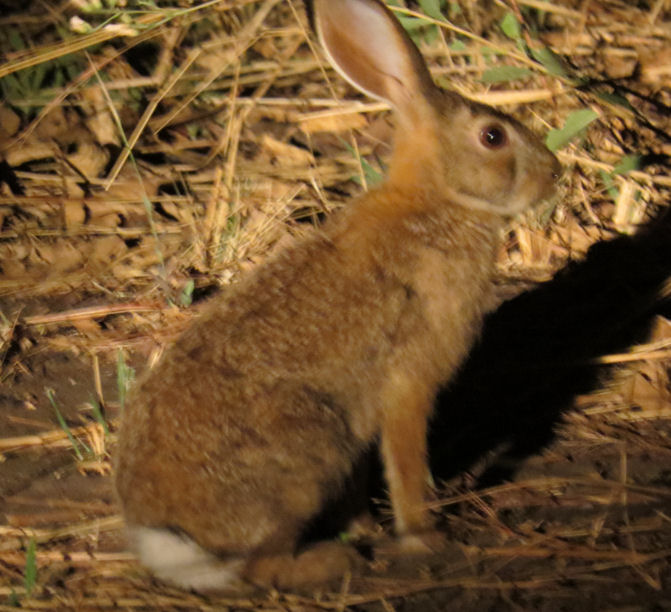Our last full day in Katavi featured an action-packed schedule. We planned to leave camp at dawn and to take breakfast in the field as we had done in the Serengeti. We also had scheduled, in addition to our regular morning and afternoon game drives, a night drive. Betty had made arrangements for this ahead of time. Molil would drive us, but we would have an additional passenger, a ranger, who would shine the searchlight, protect us from the animals, and protect the animals from us.
While we were still in camp, Molil showed us some holes in the ground, which he identified as ant lion holes. I remarked that the ant lion was one of the Little Five. No one else in our group had heard of this designation, but Julien promptly rattled off all five: lionant (or ant lion), rhinoceros beetle, buffalo weaver, leopard tortoise, and elephant shrew: two insects, a bird, a reptile, and a mammal.
Shortly after we left on the morning excursion, Molil identified four birds in rapid succession: a blue-naped mousebird, a little bee-eater, a black kite, and a capped wheatear. I managed to miss the first three, and the only reason that I got a photo of the wheatear was that I shot the entire field and located the bird when I was going through the photos.
Molil then spotted a leopard. She was resting up in a tree, as leopards are wont to do when the sun is up. Molil determined the cat's gender, not by inspecting her equipment but by the way that she was straddling the branch. He said that no male leopard would sit in such an uncomfortable position. It immediately occurred to me that female leopards ride the branches the way that cowboys ride horses, but the male leopards ride them side-saddle.
This leopard definitely called to mind the central character in my favorite Far Side cartoon of all time. For years it has occupied an honored place on the wall of my office. I never knew it before, but she was apparently a female leopard as well.
For a considerable period the leopard seemed to be interested in nothing but resting and licking. I took quite a few photos, but I was frustrated that I was not able to obtain a satisfactory view of her face. There were three problems. In the first place she was resting her head on the other side of a branch. In addition, two vines or something were directly between my location and hers. The last difficulty was that I could not stop coughing for the first five minutes or so after we arrived. This definitely affected the sound track of Sue's movies, but it seemed to have no impact at all on the leopard.
After a few frustrating minutes the other vehicle containing Matt and Hannah and Kirsten and Jan arrived. Molil pulled our Land Rover up a little. These actions perked up the leopard and gave most of us a much better view. All told, I took one hundred seventy-three photos of the leopard, and the great majority of them are nice shots. I suspect that everyone else in the group was able to do the same. We all had to laugh at how excited we had been to see the leopard in the Serengeti that was doing an impression of a rock hyrax.
This leopard spent some time licking her paws, then she seemed to be settling in for a nap, which, if she was like most cats, would probably last for the next ten or eleven hours. Molil did not think so. He noted that she looked a little hungry. He predicted that she would descend to try to catch the impala that was walking along the nearby savanna in plain sight to all of us.
The leopard eventually did perk up, and she assumed a crouched position that gave the impression that she was ready for action. After posing in a crouch for a few minutes then she relaxed again, which gave all of us a good chance to snap some stunning face shots.
This process of perking up and then settling back down was repeated, but the third time that the leopard became alert, something happened. Without warning she gracefully descended the tree, walked alongside and then behind the other vehicle from Chada Camp — they must have gotten some great photos — and then disappeared into the brush. She left all of us breathless.
Molil asked if anyone wanted breakfast. This sounded like a good idea to all of us. He drove us back down to the river where he set up camp perhaps sixty feet away from the crocodiles. These reptiles were so fat and lazy that we probably would have been safe six feet away from them.
Molil designated a boys' tree and a girls' tree. Betty walked over to the former. Tom and I took turns using the latter.
The entrée for breakfast was a bacon and egg sandwich. I felt up to trying a real breakfast for the first time in Katavi, but this one did not meet the standard set by McDonald's sausage biscuit with egg, my mainstay before morning bridge games. I did enjoy the coffee and especially the juice, which came in a box. It was called "tropical juice blend," and the name of the company was Ceres.[1]
We were joined at breakfast by a large group of hippos. I suppose that I should say that we joined the hippos. They were there before we were. Many water-birds, including some spur-winged geese, saddle-billed storks, a Goliath heron, and a spur-winged lapwing were also on hand. I got photos of the first three birds, but I missed the lapwing.
After breakfast Molil announced that we would be visiting the Hippo Pool. He proclaimed that no one could say that they had been to Katavi if they did not see the Hippo Pool.
Oh, my. The Hippo Pool was certainly a oner, as they say in the crossword puzzles. Hippos were packed cheek to jowl and every other way that one could imagine. It appeared that there was no room for even a single additional hippo, but Molil said that when the river dried up, which it ordinarily did in October or November, all of the hippos that used that water to cool off would migrate down to the Hippo Pool. At that point considerable fighting for prime locations continually would erupt among the great beasts. The Hippo Pool itself never dried up because it was fed by an underground source.
If the water in my photos of the hippos appears dark, it is because the hippos use their pool not only for cooling off but as a toilet. Many animals have disgusting habits, but for my money the hippos take the prize, at least in the mammalian category.
The hippos that we encountered were, in almost all cases, extremely docile, which is a euphemism for "lazy." Evidently, however, in certain circumstances they can be quite dangerous, both to each other and to humans. In Africa almost three thousand people are killed annually by hippos. We were quite close to the hippos at the pool, but they all ignored us.
An elephant wandered down to a section of the pool that was perhaps fifty yards removed from where the huge bloat of hippos had congregated. We dutifully took a few photos of it even though it refused to perform any tricks or stunts for us more difficult than lifting its trunk.
Near the pool were barracks for staffers of the National Park. Just as we were leaving, one of them came out to draw water from the well, which is adjacent to the Hippo Pool. I know nothing about plumbing or hydraulics, but it was hard to imagine how the water in the well could be sufficiently detached from the abundant filth in the pool to enable any safe use.
Molil showed us an interesting exhibit of skulls nearby. It included a giraffe skull, a hippopotamus skull, the top and bottom of an elephant's skull, and a buffalo's skull. The elephant's skull was enormous and extremely heavy. The jaw portion alone weighted twenty-two pounds.
We then crossed the Ikuu Bridge, which is where we obtained our best view yet of a monitor lizard. It moved in and out of the shade for us.
After that came my only true sighting of the entire trip. I was the only one who spotted a large male crocodile in a gully to the left of the bridge. Molil stopped the car and backed up. I used my monopod and the ten-second delay to snap an overhead photo of him.
As we drove back to camp, Betty thought that she saw something that might have been a lion, but when we had backed up, she could not locate it.
It might have been a mistake to eat that bacon and egg sandwich. I could taste it in my gullet. On Julien's counsel I drank a coke, which supposedly has ingredients to settle one's stomach. It did not seem to help much.
I decided to skip lunch. I am not sure what else transpired there, but I certainly missed Hannah and Matt telling about their experiences fly-camping.
I took a shower. I am not sure that I could have dealt with an outdoor shower in the evening. As it was, I was shivering at the end, but I could at least tolerate it, and the heat of the day felt good to me. I did not think that the water distribution from the showerhead was very good, but Sue claimed that I did not do it right. I also shaved. It was more difficult to do it in Katavi than in the previous locations.
I finished the second book of the Glasgow trilogy. I really abhorred the style, but I felt compelled to find out how the story ended. Also, the only other reading material I had was about bridge. That would have required more concentration than I could muster. So, I read the first two or three short chapters of the third book. I hated most of the characters, and I hoped that everyone but the girlfriend died in the end, or even earlier. In fact, I expected that the central character, a cold-blooded killer, would undergo a change of heart and become an astronaut, a missionary, or perhaps the president of FIFA.
Sue worked on her photos and videos while I tried to nap. When I shut my eyes, I kept visualizing in mind's eye the leopard coming in and out of focus. This was not pleasant, but it was not as bad as the weird massive animals of indeterminate species that appeared in my dream. They continually crushed other animals by sitting on them.
I did nap for a while, and I made a last-minute decision to join the others on the afternoon game drive. When I went to retrieve my battery from the charging station I was able to take some photos of a male vervet monkey at the birdbath. I had seen plenty of vervets, but this one was the first one that was obviously male. The males are famous for their bright blue balls.
The afternoon began with a sighting of a slender mongoose, the only member of that species that we encountered in Africa.
Most of the rest of the afternoon drive was peacefully spent watching two families of elephants and two bull buffaloes down at the water. They really got down and dirty. It was like watching my favorite event at King Richard's Faire, the Mud Show. The huge entertainers in this spectacle, however, did not at the end circulate among the audience with a muddy hat to collect donations.
We learned a little about Molil's fascinating history. He grew up as a member of the Maasai tribe. His father must have been an important figure in the tribe; he owned two hundred cattle. We learned that young Maasai men were no longer required to kill a lion with a spear to demonstrate their manliness. Instead, unless they have a disability, they were required to throw a bull. Now, I can throw bull with the best of them, but if I ever had to confront a living male member of the bovine species in unarmed combat, I doubt that I would ever prevail. In fact, I doubt that I would survive.
The adolescents in Molil's family were required to announce to their relatives at an annual gathering what they intended to do as adults. Molil's older sister was already a happy and successful teacher at a university. Molil announced to his family that he would also like to be a teacher.
Then a life-changing event occurred. Molil had the opportunity to go on game drives in two National Parks, Lake Manyara and Tarangire. He was astounded to learn about the abundance and diversity of wildlife that was just around the corner from where he had spent his entire life. Thenceforward his overarching desire was to become a guide. He faced two big problems. The first was that he had already told his family that he would become a teacher. The second was that he knew next to nothing about wildlife.
It speaks worlds about Molil that he considered the family problem the more significant and difficult. He approached his mother and disclosed his new plan to become a safari guide. She advised him that if that was what he really wanted to do, he should pursue it. She also told him not to worry about his father having objections. So, the next year Molil officially announced his change in plans to his family. They were not familiar with the tourism industry. Molil was called on to explain what a guide did. His mother helpfully added that he would really be acting as a teacher for the tourists in the National Parks. To Molil's great relief his family accepted this idea.
Molil then applied for one of the fifteen scholarships to the university in Kilimanjaro. He did extremely well on the tests, and he was awarded one of the scholarships. He studied wildlife at the university, and his dream came true. I think that the greatest moment in his life was when he was able to invite his family to come to the National Park in which he was working and take them on game drives. They were excited with the experience and impressed with their son.
So were we.
At the last campfire Julien played calls of some kind of small owl that he had recorded on his iPhone. In the distance we could faintly hear a real owl responding. Kirsten was unable to hear it, and she registered her surprise that her husband's hearing was, in this instance at least, superior to her own.
Ladies: just because we do not pay much attention to what you say does not mean that we men are losing our sense of hearing.
At supper we learned Julien's history. He was from Belgium. He had studied there to become a lawyer. He became certified to practice law, but that career only lasted for a year. He then tried out for an acting school in Paris, and he moved there and played the male lead in a play opposite a woman who later appeared in a James Bond film. He told us her name, but I do not remember it, and I did not have my notebook with me.[2]
I am not quite sure how Julien got from Paris to Katavi. Evidently the Africa bug bites a lot of people who come to the Dark Continent for a holiday and never leave. I suppose that it would not surprise me too much if he eventually moved on from managing safari camps to some other job such as Secretary General of the United Nations.
Julien reported that he maintained a blog on the Nomad-Tanzania.com website. He bemoaned the fact that his efforts to get the other managers to do the same had not met with great success.
The night drive was a hoot. We had to take a different vehicle because we had an additional passenger, the ranger. He worked the spotlight. I sat in the middle in the back. Betty wore her headlamp, but it was not powerful enough to help much.
We began the drive by driving down one edge of the airstrip. The wildlife would therefore be mostly on our right. Almost immediately we came upon a very young leopard that must have been on one of its very first solo hunting expeditions. We followed it for a short time.
Photography on a night drive is almost impossible. The camera must be aimed and ready at all times. Jeff said that his cameras did not work at night. I gave it the old college try, but the only good shots that I managed were of the leopard and the African hare.
Here is a list of what we saw: the young leopard, three porcupines (a rarity in Katavi), a white-tailed mongoose, some bush babies, a genet, a duiker, a nightjar, some hippos, two hyenas on the road, an African hare, some impalas, and a civet. Molil made a detour at the end so that we could see the civet, which was known to frequent the area of the staff's tents at nights.
I felt considerably better at the end of the day than I had at the beginning, but I was not looking forward to the bush flight scheduled for the morrow.
